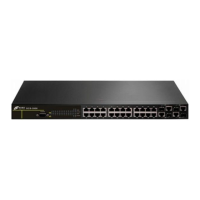109
DCS-3950 series Ethernet switch manual
Switch (Config)#no cluster run
6.2.2.2 cluser register timer
Command: cluster register timer <time-value>
no cluster register timer
Function: Set interval of sending cluster register packet, the ‘no cluster register timer’
command restores the default setting.
Parameters:
<timer-value>valid range is 30 to 65535 in seconds,.
Command mode: Global Mode.
Default: Cluster register timer is 60 seconds by default.
Usage Guide: <timer-value> is interval of sending cluster register packet.
Example: Set the interval of sending cluster register packet to 80 seconds.
Switch(Config)#cluster register timer 80
6.2.2.3 cluster ip-pool
Command: cluster ip-pool <commander-ip>
no cluster ip-pool
Function: Configure private IP address pool for member switches of the cluster.
Parameter: <commander-ip> is the IP address of the commander switch in dotted
decimal format. The value of the last byte in IP address is lower than (255-24).
Default: There is no private IP address pool by default.
Command mode: Global Mode.
Usage Guide: Before creating the cluster, users have to set the private IP address pool
in the commander switch. The cluster can’t be created if the private IP address pool is not
set. When candidate switches join the cluster, the commander switch assigns a private IP
address for each member switch. These IP addresses are used to communicate between
the commander switch and the member switches. This command can be only used in a
non-member switch. As soon as the cluster is created, the users can’t modify the IP
address pool. The ‘no cluster ip-pool’ command clears the address pool and there is no
default setting to be restored.
Example: Set the private IP address pool for the member switches to 192.168.1.64
Switch(config)#cluster ip-pool 192.168.1.64
6.2.2.4 cluster commader
Command: cluster commander <cluster-name> [vlan <vlan-id>]
no cluster commander
Function: Enable a commander switch, create a cluster, or modify a cluster’s name; the
‘no cluster commander’ command deletes the cluster.
Parameter: <cluster-name> is the cluster’s name; <vlan-id> is the VLAN of the Layer 3
device which the cluster belongs to. If it is omitted, the cluster belongs to VLAN1.

